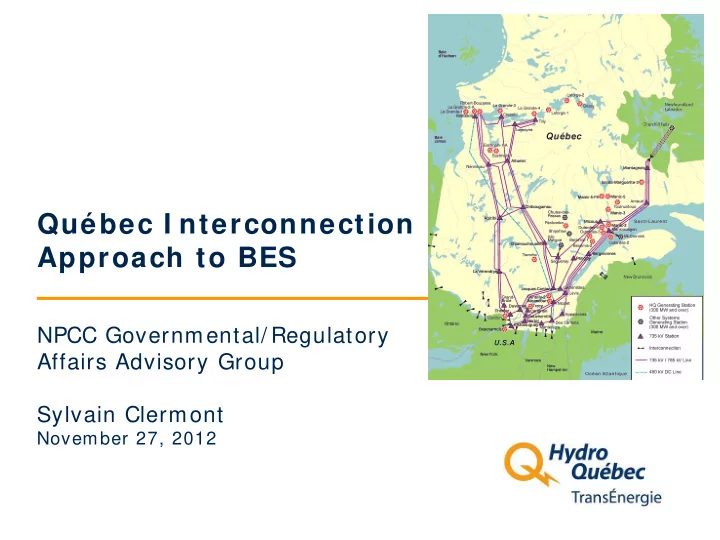

Placer une photo ici s’il y a lieu Québec I nterconnection Approach to BES NPCC Governmental/ Regulatory Affairs Advisory Group Sylvain Clermont November 27, 2012
I ntroduction: HQT Our m ission • HQT operates its transmission system, markets system capacity and manages power flows across Québec. Our Direction Contrôle des mouvements d'énergie ( System Control) acts as the Reliability Coordinator (RC) for transmission systems in Québec Our facilities • Our system, the most extensive transmission system in North America, comprises 33,630 km (20,897 miles) of line and 514 substations as well as interconnections allowing power interchanges with grids in the Maritime provinces, Ontario and the U.S. northeast Our activities • HQT owns and operates more than 95% of the transmission capacity in Québec. HQT is registered at NERC as TO, PA, TP, TSP, RC, BA, TOP and IA One entity w ith direct control and full aw areness of the w hole Québec I nterconnection Hydro-Québec TransÉnergie 2
System characteristics: reliability of the Québec I nterconnection HQT is firmly committed to system reliability, has invested in major • reliability initiatives and has learned from past blackouts The characteristics of the HQT system must be considered in • system design and operation to ensure a high level of reliability – Remote hydroelectric generation -> Criteria met without congestion – Strongly winter peaking -> Worst case scenario for planning – Strong transmission backbone -> Clear "bright line" demarcation – Local transmission subsystems -> Criteria to ensure reliability – Asynchronous with the Eastern Interconnection -> Control of the whole Interconnection • HQT faces a com bination of unique characteristics that m otivates an approach to reliability different from other I nterconnections Hydro-Québec TransÉnergie 3
Québec system design and operation Because of its characteristics, HQT’s BULK power • system must exceed NPCC and NERC criteria and standards (for certain aspects) to ensure transmission backbone reliability: – Robustness to withstand design contingencies without use of Special Protection Systems (SPS) or loss of load – Performance requirements for certain extreme contingencies Hydro-Québec TransÉnergie 4
I m pacts of the new BES definition on the Québec I nterconnection The new BES definition filed with FERC includes transmission • elements operated at 100 kV or higher Of the 474 substations that are part of our local transmission • subsystems, a majority would be included in the BES No m easurable im pact on bulk pow er system reliability; • however, increased burden for the RC and TOP Subsystem transmission projects would be required to comply with • TPL-003-1a: – SPS additions – New lines, breaker additions to existing substations, etc. Many of the subsystem SPS additions would have no impact on • service continuity Quick cost estimate for these projects: > $850 million Hydro-Québec TransÉnergie 5
I nvestm ents in reliability Demanding reliability objectives combined with the • system’s unique technical characteristics meant major investments over the years. For example: – Adoption of criteria in the late 80's triggered a $1.3-billion reinforcement project ($2-billion current) • Addition of series compensation on the 735-kV grid • Commissioning of key SPSs – Adoption of a new voltage sensitivity criterion and the need for increased transfer capability triggered a $250-million project in 2008 • Addition of series compensation and SVC's at two 735-kV substations Hydro-Québec TransÉnergie 6
I nvestm ents on HQT’s netw ork ( in m illions of $ ) 8 000 19 000 27 000 Hydro-Québec TransÉnergie Hydro-Québec TransÉnergie 7 7
Reliability fram ew ork in Québec The Régie de l’énergie du Québec (Québec Energy Board) has • exclusive jurisdiction over the entities and the framework of the Québec Interconnection and: – Has designated HQT's Direction Contrôle des mouvements d'énergie as the Reliability Coordinator (RC) for the Québec control area – Adopts reliability standards filed by the RC – Approves the Register identifying entities subject to reliability standards – Monitors and enforces compliance – Has the power to levy important fines – Has put in place consultation mechanisms in which NERC and NPCC can participate The Régie de l’énergie signed MOUs with NERC and NPCC to assist in • these functions Hydro-Québec TransÉnergie 8
Reliability fram ew ork in Québec: tiered approach to application of standards - definitions Bulk power system (BPS) • – Mainly 735-kV and 450-kV DC substations with their connecting lines and transformers – All interties with the US included in BPS Main transmission system (RTP) • – BPS facilities and some LTS (including generation assets above 50 MVA) – Facilities required for generation/ load balancing, frequency reserve, voltage control, interchange transactions, etc. – The RC has full control and visualization over RTP Local transmission subsystems (LTS) • – Operate at lower voltage levels and are connected to 735-kV substations – Feed industrial clients and load substations and connect local generation and some interconnections Hydro-Québec TransÉnergie 9
Reliability fram ew ork in Québec: a tiered approach to application of standards BPS • – All standards adopted by the Régie de l'énergie applied RTP (BPS and some LTS) • – Most standards applied, excluding TPL and some PRC standards LTS • – Standards such as TPL-001 and TPL-002 applied – Generator (50 MVA and more) requirements applied Hydro-Québec TransÉnergie 10
Reliability fram ew ork in Québec: Québec's approach An approach customized for global reliability of the • HQT system considering its special characteristics Tiered approach to application of standards • Monitoring of compliance based on that approach • Approach filed by the RC and acknowledged, but • not yet approved, by the Régie de l’énergie Hydro-Québec TransÉnergie 11
Questions? Comments? clermont.sylvain@hydro.qc.ca Hydro-Québec TransÉnergie 12
Recommend
More recommend